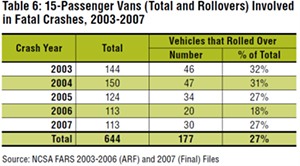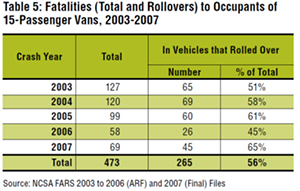Understanding the Risks of 15-Passenger Vans

Make roadways safer by practicing these measures while operating a 15-passenger van.
The use of 15-passenger vans to transport materials and people is nothing new. Demand for these vehicles has been around for several years and the need for them is not going away anytime soon. Utility/Passenger vans are less expensive than minibuses or delivery trucks and they are more economical to operate and maintain, making them a preferred choice for many different organizations in various business segments and industries.
With so many benefits, why does it seem like 15-passenger vans come under heavy scrutiny when an insurance carrier sees one on your vehicle schedule?
The increased concern with these vehicles is due to key features and characteristics that make them more likely to be involved in a motor vehicle accident (MVA). This coupled with the increased number of passengers in the van, at capacity, can lead to some terrible outcomes on the road.
Characteristics Contributing to MVAs
Higher
First and foremost, these vans sit higher off the ground than traditional vehicles. This becomes a greater concern when the vehicle makes abrupt changes in direction, such as sudden or unexpected turns. The higher center of gravity makes 15-passenger vans more likely to be involved in a rollover crash. The situation can be compounded when the weight at the center of gravity is increased with heavy objects, such as passengers, luggage or equipment. This inconsistent center of gravity can make operating these vans incredibly challenging.
Other characteristics contributing to MVAs can include the following:
- Decreased visibility. 15-passenger vans tend to have larger blind spots, which can make it more difficult for the driver to see other vehicles.
- Stopping distance. Due to the weight and size of 15-passenger vans, they take longer to come to a complete stop, when compared to sedans or other small vehicles.
- Handling difficulty. 15-passenger vans are less responsive and vastly differ in handling, when compared to smaller vehicles.
Combine all of these elements with distracted driving and higher volume levels inside the van, and the potential for an accident can increase significantly.
National Statistics for 15-Passenger Vans
According to a research note published in 2009 by the National Highway Traffic Safety Administration (NHTSA), 15-passenger vans with 10 or more occupants on board are three times more likely to roll over in a crash than those with fewer than five occupants1.
The following charts show the impact that a higher center of gravity and increased weight can have on 15-passenger vans:


This data suggests that while the overall number of 15-passenger van accidents seems to be trending downward, the number of vans rolling over in these accidents is remaining the same and the number of fatalities resulting from these rollover crashes is increasing.
Additional NHTSA data collected between 2007 and 2016 reveals the following:
- 41% of 15-passenger van occupants killed were ejected from the vehicle2.
- 11% of fatal 15-passenger van rollover accidents were attributed to tire failure2.
- 70% of 15-passenger van occupants killed in crashes were unrestrained2.
Why are more people dying in 15-passenger van rollover accidents yet the overall number of accidents/fatalities from 15-passenger van crashes is trending downwards? The answer to this question can be mainly attributed to the following key factors:
- Failure to restrain occupants with seatbelts.
- Failure to maintain tires on the vehicles.
Preventing Worst-Case Scenarios
Make roadways safer by practicing these measures on every trip:
- Prohibit inexperienced drivers from operating these vans. Oftentimes, this refers to younger drivers. However, adults should not be permitted to drive these vans until they have adequate experience.
- Refrain from traveling at excessive speeds. Slow down and give yourself more time to react.
- Avoid distractions. Set clear expectations for occupants and hold them accountable.
- Wear seatbelts. Everyone must wear a seatbelt properly, 100% of the time.
- Never load items on the roof. Instead, items should be loaded in front of the rear axle.
- Never travel with more than 15 occupants.
- Maintain the vehicle and conduct inspections before every trip. Ensure that the tires have proper air pressure and replace tires according to the manufacturer’s recommendations.
- Consider utilizing driver assistance technologies, such as electronic stability control, collision warnings, lane assist, etc.
References
1Fatalities to Occupants of 15-Passenger Vans, 2003-2007. (2009). National Highway Traffic Safety Administration.
Retrieved from https://crashstats.nhtsa.dot.gov/Api/Public/ViewPublication/811143.
215-Passenger Vans. (2019). National Highway Traffic Safety Administration.
Retrieved from https://www.nhtsa.gov/road-safety/15-passenger-vans.









